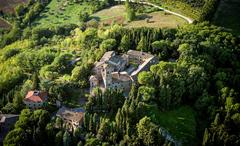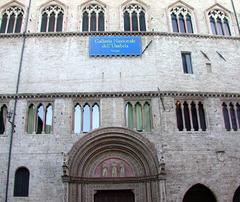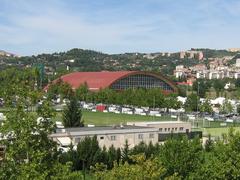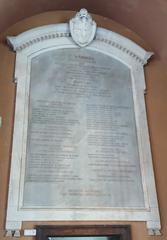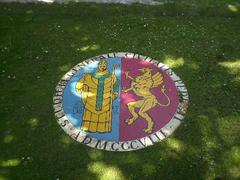
Cippus Perusinus: Visiting Hours, Tickets, and Historical Significance in Perugia
Date: 03/07/2025
Introduction: The Enduring Legacy of the Cippus Perusinus
In the heart of Perugia, Italy, the Cippus Perusinus stands as a monumental testament to the sophistication and mystery of the ancient Etruscan civilization. This rectangular travertine stele, inscribed with 46 lines of Etruscan script, is among the longest surviving texts in the language, providing critical insights into Etruscan legal practices, social organization, and culture. Discovered in 1822 near the hill of San Marco, just outside Perugia’s ancient walls, the Cippus Perusinus records a legal agreement between two prominent families—the Velthina and Afuna—illuminating aspects of property and boundary law from the late 3rd to early 2nd century BCE.
Today, the Cippus Perusinus is showcased at the National Archaeological Museum of Umbria (M.A.N.U.), an institution dedicated to preserving and interpreting the region’s rich history. This guide provides all the practical information visitors need—visiting hours, ticketing, accessibility, guided tours, and nearby attractions—alongside a detailed exploration of the cippus’ archaeological and cultural importance.
For up-to-date details and further exploration, consult the museum’s official website, Umbriatourism, or Triphobo.
Table of Contents
- Discover the Cippus Perusinus: A Must-See Artifact
- Visiting Hours and Ticket Information
- How to Get There and Accessibility
- Guided Tours and Special Events
- Nearby Attractions in Perugia
- Travel Tips for Visitors
- Historical Background and Archaeological Significance
- Linguistic and Cultural Importance
- Preservation and Museum Display
- Frequently Asked Questions (FAQ)
- Summary and Visitor Tips
- Sources and Further Reading
Discover the Cippus Perusinus: A Must-See Artifact
The Cippus Perusinus is a rectangular travertine stele, roughly 52 cm high, 32 cm wide, and 12 cm thick, featuring 46 lines of Etruscan text—making it one of the most significant surviving Etruscan inscriptions. As a legal document, it provides a rare, direct window into ancient Etruscan law and society. The cippus is now displayed in the National Archaeological Museum of Umbria, where it serves as a centerpiece among the museum’s celebrated Etruscan collections.
Visiting Hours and Ticket Information
-
Museum Hours:
- Tuesday to Sunday: 8:30 AM – 7:30 PM
- Monday: 10:00 AM – 7:30 PM
- Closed: January 1st, December 25th, and every third Sunday of the month
- Check official website for holiday updates
-
Ticket Prices:
- Standard Admission: €5
- Discounts: Available for students, seniors, groups, and EU citizens under 25
- Free Entry: Children under 18, first Sunday of every month, and select national holidays
- Combined Tickets: The Perugia Città Museo Card grants access to five city museums over 48 hours for about €14
-
Purchasing Tickets: Tickets are mainly sold onsite; online ticketing is limited, so early arrival is suggested.
How to Get There and Accessibility
-
Location: Piazza Giordano Bruno 10, Perugia, in the historic San Domenico complex
-
Public Transport: The “Tre archi” bus stop is approximately 200 meters from the entrance; the MiniMetro light rail connects lower Perugia to the historic center
-
Parking: Limited street parking nearby; disabled parking available along Corso Cavour or inside the cloister by prior arrangement (+39 075 5727141)
-
Accessibility:
- Wheelchair accessible with ramps and elevators
- Some reconstructed tomb exhibits may have limited access
- Restrooms and a cloakroom are available
(Umbriatourism.it, Nomads Travel Guide)
Guided Tours and Special Events
- Guided Tours: English-language tours are available by request or during special events
- Audio Guides: Recommended for non-Italian speakers; limited English signage on displays
- Digital Resources: Use the Audiala app or GPSmyCity for self-guided tours
- Events: The museum hosts temporary exhibitions, workshops, and lectures on Etruscan archaeology. Check the event calendar for updates.
Nearby Attractions in Perugia
Enhance your visit by exploring Perugia’s historical landmarks within walking distance:
- Etruscan Arch (Arco Etrusco): Imposing city gate from Etruscan times
- Rocca Paolina: Renaissance fortress built over Etruscan ruins
- Perugia Cathedral: Gothic architecture and religious art
- Piazza IV Novembre: Main square with lively cafés and events
- Etruscan Well and National Gallery of Umbria: Notable sites for those interested in local art and archaeology
Travel Tips for Visitors
- Wear comfortable shoes for hilly, cobbled streets
- Allocate at least 2–3 hours for the museum
- Bring a translation app or guidebook for non-Italian signage
- Photography is generally allowed without flash or tripods; confirm policy at the entrance
- Visit during weekday mornings or late afternoons for fewer crowds
- Check for free entry days and special events
Historical Background and Archaeological Significance
The Cippus Perusinus was unearthed in 1822 on the hill of San Marco. Measuring approximately 52 cm by 32 cm by 12 cm, it is inscribed with 46 lines of Etruscan text. The document details a legal agreement between the Velthina family of Perugia and the Afuna family of Chiusi, illuminating Etruscan property and boundary law during a period marked by increasing Roman influence. Its discovery cemented Perugia’s importance in Etruscan studies and provided a foundation for deciphering and understanding the Etruscan language.
(droitromain.univ-grenoble-alpes.fr)
Linguistic and Cultural Importance
The cippus’ lengthy inscription is pivotal for linguists and historians, offering rare, direct evidence of Etruscan legal language, social structure, and onomastics. The inscription contains legal formulae, proper names, and unique terms that have been referenced in scholarly works by Pallottino, Bonfante, and Rix. As the Etruscan language remains only partially deciphered, the Cippus Perusinus is invaluable for ongoing linguistic research.
(Archive.org, Studietruschi.org)
Preservation and Museum Display
The Cippus Perusinus is presented in a dedicated Etruscan section of the museum, protected in a climate-controlled case with interpretive panels. The exhibition contextualizes the stele among related funerary and legal artifacts, including the reconstructed Cai-Cutu tomb and other Etruscan inscriptions. The museum’s chronological layout guides visitors through the evolution of regional cultures from prehistory to the Roman era.
(Katy in Umbria, whichmuseum.com)
Frequently Asked Questions (FAQ)
Q: When is the museum open?
A: Tuesday to Sunday, 8:30 AM – 7:30 PM; Monday, 10:00 AM – 7:30 PM. Closed on major holidays.
Q: How much is admission?
A: Standard ticket €5; free on the first Sunday of the month and for children under 18.
Q: Is the museum accessible?
A: Yes, wheelchair access and facilities for visitors with disabilities are available.
Q: Are guided tours available in English?
A: Yes, by request or during special events. Audio guides and digital resources are also recommended.
Q: Can I take photos?
A: Photography without flash or tripods is generally allowed; check specific policies at the entrance.
Summary and Visitor Tips
Visiting the Cippus Perusinus at the National Archaeological Museum of Umbria is an unparalleled opportunity to engage with one of antiquity’s most significant legal and linguistic artifacts. The museum’s thoughtfully curated exhibitions, accessible facilities, and rich historical context make it an essential stop for anyone interested in Etruscan history. Enhance your experience by exploring nearby landmarks, using digital resources for interpretation, and planning your visit during quieter periods. Always consult the museum’s official channels for the latest information on hours, tickets, and special events.
(Museo Archeologico Nazionale dell’Umbria, Umbriatourism.it, Katy in Umbria)
Sources and Further Reading
- Museo Archeologico Nazionale dell’Umbria Official Site
- GoAskALocal
- Katy in Umbria
- Umbriatourism
- Triphobo
- Nomads Travel Guide
- WhichMuseum
- droitromain.univ-grenoble-alpes.fr
- Studietruschi.org
- Archive.org
- GPSmyCity
For more travel tips, download the Audiala app for audio guides and the latest updates. Share your experience and follow us for ongoing coverage of Perugia’s historical treasures.

